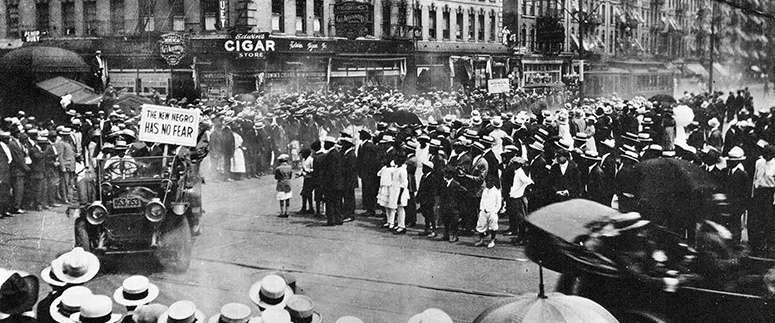THE NATION CLASSROOM
History as It Happened
RACE RELATIONS and CIVIL RIGHTS
MODULE FOUR: 1919-1929
PERIOD SUMMARY: As some 350,000 African-American US soldiers returned from service in World War I (1914–1918), they found the injustices of their home nation unchanged. Racist Jim Crow laws enforced segregation and unequal citizenship in the South. Determined to find a better life, some half a million black southerners moved to the industrial cities of the North. There, they competed with white immigrants for jobs and housing, which increased tensions between the races.
Before World War I, the NAACP had just 9000 members nationwide and only 300 in the South, but by the early 1920s, national membership had risen to 100,000, with Southern chapters constituting a slight majority. African-Americans had returned home from the war with new and contagious confidence and assertiveness.
In the “Red Summer” of 1919, a widespread series of urban race riots broke out, initiated by whites, in which scores of black people were lynched and thousands were terrorized—while law-enforcement and government representatives generally did nothing. Many African-American veterans played an active role in defending their communities during Red Summer. In 1921, mobs of white residents attacked black residents and businesses in the Greenwood District in Tulsa, Oklahoma in what has been called “the single worst incident of racial violence in American history.” The attack destroyed the thriving business district known as the “Black Wall Street,” then the most affluent black community in the United States, along with the surrounding residential area and resulted in as many 300 deaths.
Despite this atmosphere of noxious racism, African-Americans achieved extraordinary things in the arts, education, sports, and other fields during these years. In particular, black artists created enduring literary, musical, and visual-arts works in a movement known as the Harlem Renaissance, a turning point in black cultural history which helped African-American writers and artists gain control over the representation of black culture and experience in Western high culture.
Below you’ll find excerpts from selected articles about this era that ran in The Nation during that time.
The DBQ (document-based question) about this set of excerpts is: In the 1920s, Americans had widely differing opinions about the proper status of African Americans in US society. Discuss those contrasting ideas, and demonstrate ways in which they were expressed during the decade.
AS YOU READ: Things to Look For
- Recall. Which documents point to African-American achievements? Which ones point to hindrances to opportunity?
- Analyze content. Most of the authors below played significant roles in the events of that decade. Try to identify the writer’s race based on the document’s content. How do you know? Which selections are more ambiguous as to the writer’s race? Why?
- Identify context clues. The word chivalry is used in two separate excerpts (once in its adjective form, chivalrous). What does the word mean, and how does its usage alert you that it might have particular significance? How might the concept of chivalry fit into the historical theme being discussed here?
- Create meaning. From the examples given here, as well as your previous knowledge of the era, determine two main opposing forces that drove the events of the decade, particularly as they relate to civil rights.
VOCABULARY
Armistice
chivalry/chivalrous
gold star (family)
lynching
white supremacy


